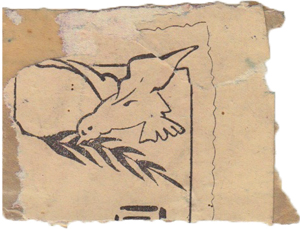Lynching In America: A Grim History
My letter responding to this was published in today’s New York Times.
To the Editor:
The report on lynching is a deeply needed review of the legacy of racial terror in American life. But the truth and reconciliation called for in the Equal Justice Initiative report is also needed for the scores of racially motivated extrajudicial killings and other acts of racial terror during the civil rights period of the 1950s and 1960s. People directly affected by these more recent acts are still living today — largely without recognition and without closure.
A groundbreaking bill sponsored by Representative John Lewis, a civil rights hero, and signed into law in 2008 reopened 113 race-related murder investigations of civil rights workers and ordinary people.
To date, more than 100 of the cases have been closed by the Justice Department without prosecutions — closed quietly, without public notice. Journalists and legal advocates have questioned the Justice Department’s seriousness about identifying cases, resolving them and providing adequate information to victims’ families about what happened to their loved ones.
The United States must grapple not only with the findings reported in The Times but also with a longer legacy of violence.
BEN GREENBERG
February 19, 2015 lynching letter to the editor new york times civil rights movement civil rights era equal justice initiative department of justice racial violence john lewis cold case publication
It Was His Job to Enforce the Law
Lyndon Johnson was president—the executive branch of the federal government. It was his job to enforce the law. He should not have waited until Jimmie Lee Jackson’s, James Reeb’s and Viola Liuzzo’s lives were taken. He should not have waited until people were beaten and bloodied on Pettus Bridge before he enforced Negroes’ right to vote in the South. I appreciate LBJ’s enacting and signing the Voting Rights Act, but I wish he had been a self-starter when it came to our right to vote, so it would not have been necessary to go to the lengths that we did—organizing a mass movement and risking our safety–in order to get the vote.
It was the courage, work, thoughtfulness, sacrifice, discipline and determination of citizens of the United States that obtained our right to vote.
Historically, inventions, musical innovations and many more accomplishments and contributions developed by descendants of enslaved Africans in America have been misappropriated. We learn about presidents, battles and dates. The impression too often perpetuated in history books and in popular culture is that that you have to be a president, someone special or White to have an important idea or to achieve major accomplishments. This is an idea that disempowers citizens and should not be propagated further.
February 12, 2015 civil rights movement selma jimmie lee jackson viola liuzzo james reeb voting rights lbj lyndon b. johnson diane nash
Alabama Goddam
DeKalb County, Alabama superintendent of schools Hugh Taylor has nixed the Collinsville High School history club’s request to take students to a screening of Selma in nearby Gadsden. Taylor’s objection to students making a school sanctioned and funded trip to see the film has gotten people talking about new South discomfort with frank representations of old South realities. More is at stake here, however, than whether DeKalb County students are allowed to see the film as part of a school history club activity. The Collinsville High history club should be allowed to take students to Gadsden to see Selma. But what about making the 25 mile drive to Gadsden to learn about Gadsden?
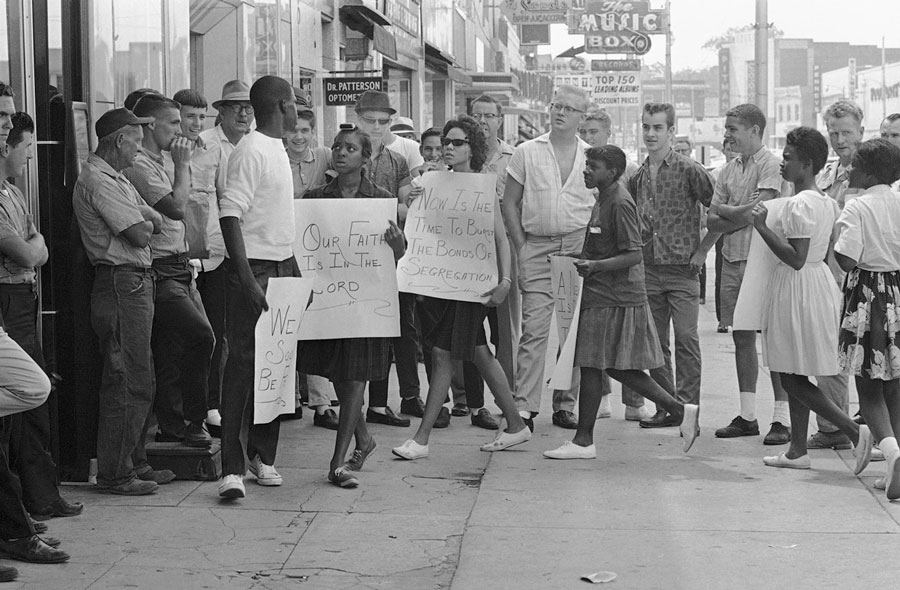 A picketer in front of a Gadsden, Alabama, drugstore turns to answer a heckler during a demonstration, on June 10, 1963. (AP Photo)
A picketer in front of a Gadsden, Alabama, drugstore turns to answer a heckler during a demonstration, on June 10, 1963. (AP Photo)
Taylor was worried about what the school’s “multicultural” students might hear in Gadsden.
Taylor cites the website “Kids In Mind” when explaining his decision. The site advises that the movie “Selma” has “about 2 F-words (and) 26 derogatory term (sic) for African-Americans.”
“I understand the movie has a lot of historical value,” Taylor told AL.com Thursday morning. "The request was denied based on language. (The website) told me there were about two F-words in that movie, which I presume may mean more. The school that wanted to go (Collinsville High) is a multicultural school and (the website) said there were going to be 26 African-American connotations, which I thought would probably be inappropriate.
“I deemed this movie in particular inappropriate and that’s my job as the head of the school system to make those decisions,” he said.
The National Coalition Against Censorship questions Taylor’s objection to Selma’s language and raises concerns about keeping high school students from seeing the film.
Throughout history, citing a piece’s “dirty words” has been a cornerstone of censorship. Words may offend our delicate sensibilities, particularly when those words are decontextualized from the artistic work at hand. Profanity has increasingly, however, become a convenient veil for masking more damning, openly discriminatory ideas of what should be censored.…
Whatever the reason for Taylor’s decision, the result is especially disheartening when considering the film’s critical adulation. Some have gone as far to say that Selma should be regularly shown in US public schools for its incisive and humanistic rendering of one of our country’s most vital historical moments.… Selma is … a film that’s been shepherding in a more informed, urgent conversation about civic protest movements, our country’s contested history of race relations, and who gets to tell historical narratives.
Others share the NCAC’s concerns about censorship and question whether Hugh Taylor is truly worried about the language the Collinsville High students might hear in Gadsden or if his objection is to the film’s depictions of Alabama’s racist past. Mother Jones notes, for example, that “Alabama is one of three states in the country that simultaneously observes Robert E. Lee Day alongside Martin Luther King Day.” The blogger “Field Negro” wonders whether Taylor’s problem is that he “had some relatives who are on the wrong side of history when it comes to what went down in Selma.”

Two years before the events portrayed in Selma, Gadsden was a flashpoint of civil rights activism and brutal racist reprisals no less horrific than the police brutality of Bloody Sunday in Selma.
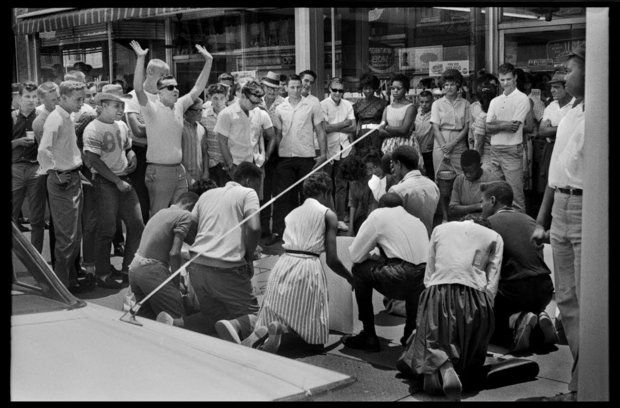 Demonstrators gather on a sidewalk under the taunts of whites on June 15, 1963. (Photo by Anthony Falletta)
Demonstrators gather on a sidewalk under the taunts of whites on June 15, 1963. (Photo by Anthony Falletta)
Eric Rainey worked for the Student Nonviolent Coordinating Committee in Gadsden in 1963. He reported:
Demonstrations began in Gadsden on June 10, 1963. There were five hundred people in the streets downtown demonstrating for their freedom. We demonstrated for two weeks and only two persons were arrested: Nandy McNair and myself. We were arrested following a protest at the county court house but were released the next morning. When we were jailed, one of the officers stepped on my face and kicked me about seven or eight times.
After two weeks of demonstrations we learned that the sheriff had sent for the state troopers. On the day the troopers were supposed to have arrived we went downtown and closed the lunch counters again and picketed in front of the theaters. About fifty people were arrested. We walked to the court house to protest the arrests and sat down in the middle of the street. At that time three hundred people were arrested and by the time the state troopers arrived that evening there were six hundred people on the court house lawn praying for the release of their people from the jail.
Women had babies in their arms and there were many young children sitting on the lawn. The state troopers sneaked up on the people and began beating them as they prayed. There was a lady standing with her baby in her arms on the court house steps and the troopers knocked her down and pushed the baby from her hands. Some were knocked down two and three times. There were so many people arrested that the jails were filled. The men were sent to Camp Gadsden, others were sent to the city and county jails. We stayed in jail for fourteen days and were released on bond. When our trial came up the judge postponed the trial indefinitely.
On July 11 about twenty-eight of us demonstrated again and were arrested for “vagrancy.” We stayed in jail six days and were released. After being released from jail this time, we set our sights for another demonstration on August 3, 1963 which we called D-Day. We began going into the communities talking to everyone about getting out on this date. The police followed us everywhere we went. We always carried our tooth brushes with us to be prepared in case we were arrested. On D-Day there were close to 2,300 people ready to demonstrate. We went downtown and picketed again.
That evening we had another mass demonstration. About 1,200 people were arrested and in order to make room in the jails, some youths were released as juveniles. There were about six hundred and fifty people still in jail after some were released. This was the largest mass jailing of any civil rights demonstration up to that time, north or south. The beatings by troopers and police continue. There is need for federal intervention by the President and Attorney General.
My father’s friend William Douthard was also in Gadsden in 1963, as a Congress of Racial Equality (CORE) field secretary, organizing the protests.
It was there the ‘cattle prod,’ a battery powered instrument used in most stockyards, capable of rendering a shock from 18-24 volts, was introduced as a weapon against civil rights demonstrators. It was there the theory of brutally beating Negroes in large numbers as a means of creating a blanket of fear in the community was initiated in the grandest of Southern style.
The same Col. Al Lingo of the Alabama Highway Patrol who at the Edmund Pettus Bridge in Selma ordered state troopers to advance on horseback, gassing and marauding unarmed civil rights marchers, was there in Gadsden as his state troopers cattle prodded protestors.
Douthard (known to many as “Meatball”) recounted his arrest, along with another CORE field secretary, Marvin Robinson, following protests on June 19, 1963.
Ironically, Marvin was walking to the Federal Building to protest to the F.B.I. a merciless beating inflicted upon me the day before by State troopers while a crowd of about 200 whites watched. After placing us in the car, Brown, while the other trooper in the car watched us, called Col. Al Lingo, Director of Alabama State Highway Patrol, and said:
“I’ve got Robinson and Meatball here, what do I do with them?” “Bring them in,” said Lingo, to which Brown replied, “On what charges?” “Disturbing the peace or anything,” said Col. Lingo. We were then taken to the back of the Etowah County Courthouse, where awaiting us stood Col. Lingo and his driver, Maj. Allen.
From our first encounter, Col. Lingo set the pace for our trip from the basement to the fourth floor via elevator. Approaching the steps to the basement of the courthouse, I was prodded by Brown. As we walked inside I mistakenly walked by the door that Lingo apparently intended for us to go through. Lingo then reached out, turned me around and slapped me through the door.
Marvin then made his mistake, by walking up the stair instead of down the corridor toward the elevator as I did. He paid for his mistake. Allen ordered Marvin down, and then began punching him in the stomach. After Allen had punched Marvin about four times, Brown began prodding him toward the elevator.
Marvin and I were then herded into the alcove opposite the elevator. Brown then began to consistently alternate in prodding Marvin and me. While leaning against the wall under pressure of the prodding, Marvin’s leg gave in and he slipped to the floor. Immediately they pounced on him—Allen punching and kicking while Brown held the prodder to Marvin’s chest. When Marvin started yelling in pain, Allen ordered a halt until we go in the elevator so as to minimize the chances of being heard. After entering the elevator, we were constantly punched and prodded until we reached the fourth floor.
The two historical photos in this post were the only ones of the 1963 Gadsden protests that I found published online. The pivotal 1965 Selma to Montgomery March is the stuff of mainstream Hollywood film because the historical moment’s images, footage and key events are already so indelibly part of popular culture and the canonical stories of the civil rights movement. There is much more, however, that will never filter into popular films and can only be known and understood by tending to living witnesses and participants—many of whom have already died.
With hundreds of local Gadsden residents having taken part in the 1963 protests, surely some of the protestors are still around today and could provide Collinsville High students a more palpable and meaningful connection to the civil rights movement and the nature of state sponsored violent reprisals against it than can any film. The real tragedy in this story is not Hugh Taylor’s wrongheaded censorship of a notable two hour historical drama but the abundance of missed opportunities by American communities—Southern and Northern, alike—to face the violence perpetrated to uphold white supremacy and understand the history of struggle against it.
Correction
I originally wrote that Eric Rainey was field secretary for the Student Nonviolent Coordinating Committee in Gadsden. According to SNCC veteran and oral historian Sheila Michaels, Mary Hamilton was the SNCC field secretary in Gadsden. In our discussion on Facebook, Sheila added:
Mary was jailed for Gadsden. William [Douthard] was her protégé (remember, he was only 18 years old when he came to NY). CORE (& SNCC) worried a lot about “contributing to the delinquency of minors” which had very serious consequences for both the adult & minor. No one wanted to go to reform schools, because they didn’t have to let you out until you reached your majority. Mary had a few people who were underage under her protection. We barred a lot of kids from the office in Hattiesburg.
January 28, 2015 civil rights movement alabama selma gadsden collinsville censorship hugh taylor william douthard sncc core eric rainey marvin robinson
Honey I Am Really Scared this Time
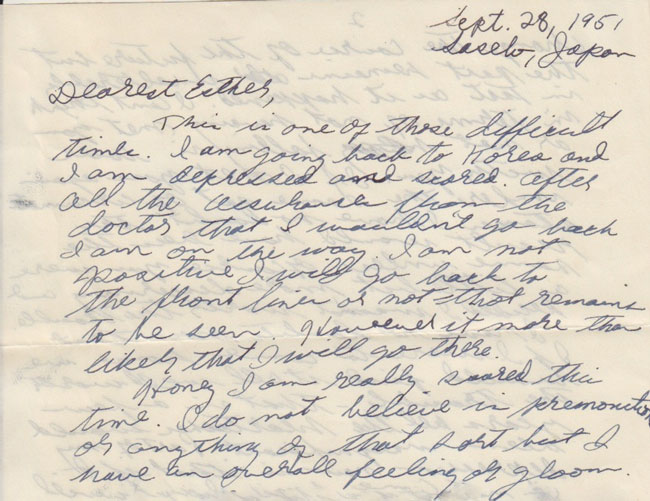 Letter from Paul Greenberg to Esther Greenberg, Sept. 28, 1951 (excerpt)
Letter from Paul Greenberg to Esther Greenberg, Sept. 28, 1951 (excerpt)
In this letter, we return to Sasebo, Japan in September of 1951, where my father was recovering from a massive case of dysentery. He is about to be sent back to Korea, possibly again to the front lines, and he shares his fears with my mother. My parents married secretly in the fall of 1950, after my father finished basic training in the States and before he went overseas to Korea. On February 10, 1951, they had a public wedding, while my father was home on a leave. My parents did not live together as a married couple until his honorable discharge from military service in June of 1952.
September 28, 1951
Sasebo, JapanDearest Esther,
This is one of those difficult times. I am going back to Korea. After all the assurances from the doctor that I wouldn’t go back I am on the way. I am not positive I will go back to the front lines or not. That remains to be seen. However it is more than likely I will go there.
Honey I am really scared this time. I do not believe in premonitions or anything of that sort but I have an overall feeling of gloom.
If I were going off to fight for something I really believed in something worth fighting for I might be scared for I believe the man who is not afraid of death is foolish but this way — there is so much left behind, so much to do and to say.
I hate to be depressing honey but I have to let it out. If anything should happen and I do not come back you must know how much you have meant to me. There is no sense in wishing that things had been different. You you may change the course of the future but the past remains unalterably intact as it happened. I can’t think in terms of not having met you or not falling in love with you. If I met you again under the same set of circumstances I have no doubt the result would have been the same unless of course you were a little bit more discerning and decided I wasn’t wroth the trouble.
I have no doubts now that if I were to come home we would find it all well worth the trouble — that in a few years all the heartaches would seem insignificant. Part of my depression now is that if I do not come home I never will have the chance to prove that. I am not trying to write a premature last will and testament. No lines of what I would like you to do. I think you know that. I want you to be happy and until now you have had very little happiness because of me. To the contrary you have had a good deal of unhappiness. I can’t say, “if anything happens don’t feel badly, don’t mourn ect [sic]” I would be very hurt if I thought you wouldn’t. I haven’t the mental energy right now to detail it but we both know what we believe and more or less what we want and I want you to have it regardless. I think this is the the crux of what I have to say about the future.
On a less pessimistic note, if and when I do come home I will be a much better person a much stronger person than when I left. It may take a while for me to settle my nerves but this is normal. After all at best all is nerve wracking and abnormal here. This last too is testament to what you mean to me honey. Gloom and all I can’t think of a future with out you and there is a strong drive to preserve myself for that future. Believe me honey that is a tremendous thing. I have seen men die for the lack of the same. I might have myself if it was not with me all the time.
This is all beginning to sound like a last letter. Maybe I am too tired now. I did spend 20 hours on the train getting here. I will write again tomorrow. I love you always
Paul
November 19, 2014 sasebo japan korea korean war last will and testament letters
On a Train through Hiroshima in 1951
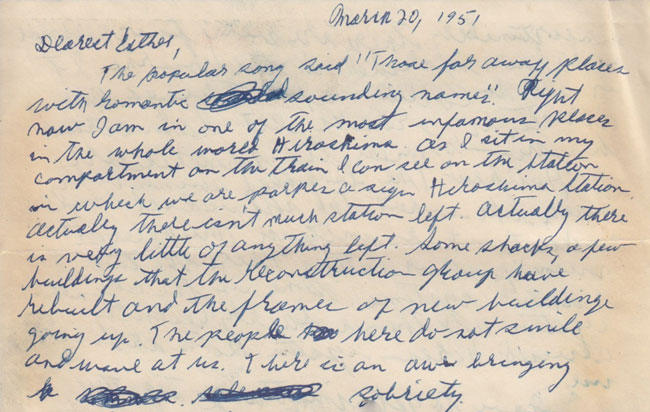 Letter from Paul Greenberg to Esther Greenberg, March 20, 1951 (excerpt)
Letter from Paul Greenberg to Esther Greenberg, March 20, 1951 (excerpt)
My father had already seen months of combat in Korea by this March train ride through the Japanese countryside. Within a matter of days, as his letters reflect, he would be back to combat in Korea. I have not yet found a letter that gives context to this stint in Japan, to where he’d return in September, to recuperate from dysentery.
In later years, my father recalled having a “profound religious experience” in Hiroshima during one of his stints in Japan during the Korean War:
In the Hiroshima Museum there is a wall, all that is left of a building destroyed by the bomb. On that wall is etched the shadow of human beings which is all that is left of them. It was there that I came to understand that the distinction between just and unjust wars was blurred and that human existence was at great risk and that only a spiritual revolution would be sufficient if humanity was going to survive.
Whether the recollection occurred on this or another wartime trip to Japan, it is chilling to imagine this train ride through Hiroshima in 1951.
March 20, 1951
Dearest Esther,
The popular song said “Those far away places with romantic sounding names.” Right now I am in one of the most infamous places in the whole world Hiroshima. As I sit in my compartment on the train I can see on the station in which we are parked a sign Hiroshima Station. Actually there isn’t much station left. Actually there is very little of anything left. Some shacks, a few buildings that the reconstruction group have rebuilt and the frames of new buildings going up. The people here do not smile and wave at us. There is an awe bringing sobriety.
As I travel along the Japanese countryside I see many schools. The people seem most industrious. Everyone seems busy all the time.
The list of subversive organizations here is tremendous. Everything from a communist party to the Green Dragons which is a super nationalist organization.
Letter from Paul Greenberg to Esther Greenberg, March 20, 1951 (excerpt)
You will have to pardon the writing. Japanese trains are old and rock worse than a ship in a storm.
I am studying the Korean language. A few of us with high IQs were given books on how to learn the basic phraseology of the Korean language. Unfortunately there are very few personal phrases included in the course. It is all so called useful things like directions, orders ect [sic]. I am struck by how similar the phonetics are to Hebrew. The language sounds very much like what the individual words indicate. For instance muyylegut [meoggi, 먹기] means “food” or eating. There are two number systems. One is the Chinese system and then a fairly recently devised Korean system. Both are in use.
I have to get my things together and get ready to change trains so I will finish here. Maybe the next letter will be smoother. I love you
Paul
November 18, 2014 letters japan korea korean war paul greenberg esther greenberg hiroshima atomic bomb hebrew korean chinese train
More Interesting than the Sergeant Realizes
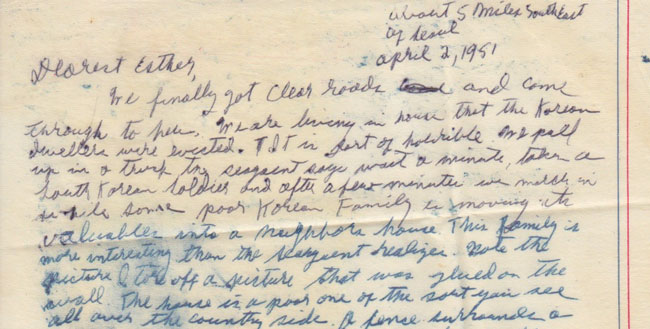 Letter from Paul Greenberg to Esther Greenberg, April 2, 1951 (excerpt)
Letter from Paul Greenberg to Esther Greenberg, April 2, 1951 (excerpt)
This letter is quite a glimpse into the complexities of my father’s wartime experience. It is reassuring and moving to witness his horror at the eviction of a Korean family from their home so that it can be turned over to his troop as a place to stay. I like how he uses his discomfiting access to the evicted family’s home to try to restore some measure of their humanity and to see the cultural richness and poltical nuance in their lives. And yet he cannot entirely escape his own position as a western, military invader. Why did he think it okay to tear off the piece of a picture from the wal of the evicted family’s home? Why is it okay for him to send it home to my mother? Sixty-three years later, I have found this nameless Korean family’s peace dove, still folded into the pages of the letter. It is a remarkable artifiact. I should not possess it.
About 5 miles southeast of Seoul
April 2, 1951Dearest Esther,
We finally got clear roads and came through to here. We are living in a house that the Korean dwellers were evicted [from]. It is sort of horrible. We pull up in a truck. The sergeant says wait a minute, takes a South Korean soldier and after a few minutes we march in while some poor Korean Family is moving its valuables into a neighbor’s house. This family is more interesting than the sergeant realizes. Note the picture I tore off a picture that was glued on the wall.
The house is poor one of the sort you see all over the country side. A fence surrounds a small area of land. Within the fence are several rooms and a platform. The middle is bare earth and bare sky. Along the ceiling is an ingenious method for storage space. Sliding panels open and serve as drawers and closets. One room has a fire hearth with three holes each big enough to hold a different size crockery bowel for cooking. On each side of the 4 sides is an exit. These people have a box of Chinese phonograph records. They look terribly interesting. I wish there was a vic here and also I wish I could read Chinese. Seoul is really a rubble. Very few buildings are standing. Those that are standing are smashed up inside. The city is overrun with Americans, British, Turkish, and South Korean soldiers. It seems the civilians there are all there for the purpose of selling to soldiers: silks, liquor, prostitutes, candy, labor and assorted souvenirs.
One more thing I need honey. I hate to be a pest but I need a metal soap dish and a metal toothbrush case (a toothbrush enclosed). The plastic ones break too easily. I feel terrible when I complain about my physical condition. All these men have been wounded or have things like dysentery or yellow jaundis [sic]. However complain I will until I get out of the Infantry.
I haven’t seen the newspaper in a few days but optimism runs high here. People are betting that this mess will be over in 2 to 3 weeks. I sure hope so. There is a good chance that I will get some of my mail here. That would be the best thing that happened in a long time.
I saw a weather report that said it was still quite cold in New York. By now spring must be there. I bet the park looks beautiful: green and even some flowers showing through. I am afraid that I won’t go much for walking when I get home, not for a while anyway but the idea of a walk in the park with you pleases me.
I have early guard duty tonight (I get some sleep at least) so I have to close now
Good night prettyface until tomorrow
Paul
November 18, 2014 letters paul greenberg esther greenberg korean war seoul korea new york city
How Ferguson Showed Us the Truth about Police
Artwork by @MollyCrabapple
November 18, 2014 ferguson police brutality michael brown eric garner darrien hunt alejandro nieto ezell ford john crawford darren wilson fusion video youtube molly crabapple
Detroit Needs this White Dude to Wash His Balls
The Daily Show’s Jessica Williams investigates Detroit’s aggressive water shutoffs, which targets many of the city’s poorest residents while leaving large commercial properties unscathed.
November 18, 2014 detroit water human rights daily show jessica williams video
It Is Hard to Believe Anyone Could Ever Forget
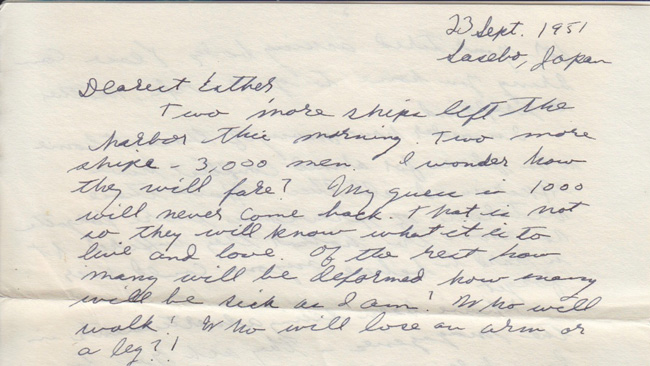 Letter from Paul Greenberg to Esther Greenberg, Sept. 23, 1951 (excerpt)
Letter from Paul Greenberg to Esther Greenberg, Sept. 23, 1951 (excerpt)
After close to a year of combat in Korea in September 1951, my father contracted dysentery and was sent for treatment at a military hospital in Sasebo, Japan. He wrote this letter to my mother from the hospital in Sasebo.
23 Sept. 1951
Sasebo, JapanDearest Esther,
Two more ships left the harbor this morning. Two more ships. 3,000 men. I wonder how they will fare? My guess is 1000 will never come back. That is not so they will know what it is to live and love. Of the rest how many will be deformed, how many will be sick as I am? Who will walk! Who will lose an arm or a leg?!
To many people at home peace means many things. Economic security, keeping their loved ones ever near or maybe just an ideal a good ideal. But how many know what it means to the 3,000 on these ships? How many know what it means to the close to 200,000 combat soldiers here (not including the Chinese and North + South Koreans)? How many have seen a man laugh when his best friend was killed. Not laughter of delight but laughter of relief—gladness that it wasn’t he who was killed. Who knows what it is to stay awake hoping that you will live through just one more night. If you live tonight maybe you will live tomorrow night.
Peace can stop the noise of the big guns forever trying to find you with their missiles of death and deformity. Peace can stop the endless marches which always end with bullets. Peace can stop those bullets from searching for your tired aching body. Peace can bring you home to your wife, mother, girlfriend.
I wonder how many of those at home who press for armed conflict have experienced all this. Have those veterans of previous wars forgotten so soon the horror they suffered? It is hard to believe anyone could ever forget.
I have been seeing advertisements in the magazines — they ask you to buy defense bonds for the memory of a brave dead young man who was killed in Korea. Why — they do not say so but it is to put another young man in his place. I read about how our men must be armed. Are we just entities that should be armed, lead an abnormal existence until our lives are cut short by death or wound? Don’t we have the right to live to love to carry on a normal existence?
In the past I have always claimed that in order to convince people to act on a situation you must show them how it will affect them if they do and how if they don’t act. But surely people must grasp that bigger than any ideology and economic gain, religious or political belief is the saving of the lives of our young.
I have purposely avoided what this means in terms of the Chinese or Korean people. I feel certain it is the same.
What has 15 months of war accomplished? Scores of thousands of young men killed. Many more than can be counted are wounded. Millions of people are homeless. Infants starve, cry for lost or dead parents. Cities are ruined. I wonder how much worse it could have been for South Korea under North Korean rule or vice versa. I doubt if the difference in an ordinary person’s life would have changed one bit noticeably. But those 3,000 who leave tomorrow. Those 3,000 who have left almost daily for a year now what of them? Almost all of us have our answer. Peace! Peace and the right to make our own destiny at home.
I guess I got in an speechifying mood. I get this way whenever I hear a news broadcast or read time or newsweek magazines.
The weather is beautiful. An early fall day. Bright and with just a touch of a chill in the air. Everything is bright and green and comfortable. Just the kind of day to do lots of exciting things and come home with flushed cheeks and happy smiles and feel refreshed rather than worn out.
We could go to the Museum and Central Park maybe even row in the lake. Eat in a fancy restaurant and go to a show or movie and then to our home. Oh how I long for a day like that. To me right now it seems like the ecstasy of ecstasies.
They are bringing me my lunch now and for the first time in days I feel hungry so good afternoon prettyface. I love you—
Paul
November 15, 2014 letters dad mom esther greenberg paul greenberg army korean war sasebo japan
Beginning of the End
The American Psychological Association has announced that it will conduct an indepenedent review of its role in US torture during the Bush administration. James Risen reports for the New York Times:
The nation’s largest organization of psychologists will conduct an independent review into whether it colluded with or supported the government’s use of torture in the interrogation of prisoners during the Bush administration.
The American Psychological Association said in a statement released late Wednesday that its board had named David H. Hoffman, a Chicago lawyer, to conduct the review.
For years, questions about the role of American psychologists and behavioral scientists in the development and implementation of the Bush-era interrogation program have been raised by human rights advocates as well as by critics within the psychological profession itself. Psychologists were involved in developing the enhanced interrogation techniques used on terrorism suspects by the Central Intelligence Agency. Later, a number of psychologists, in the military and in the intelligence community, were involved in carrying out and monitoring interrogations.
In an interview, Mr. Hoffman, a former federal prosecutor and onetime inspector general of the city of Chicago, emphasized the independence of his investigation. “We will go wherever the evidence leads,” he said.
In 2006, I began my first online communications job at an organiztion called Physicians for Human Rights. PHR had recently published its groundbreaking report, Break Them Down: Systematic Use of Psychological Torture by US Forces, which was the first explanation of how psychological torture became part of the so called US war on terror. Though we would come to learn much more about the insidious and corrupt invovlement of psychologists in the US torture regime, it was already clear to PHR’s Campaign Against Torture team that US torture could not go on as it had if health professionals would abide by their professional ethics and abstain from participation in interrogations. In the spring of 2006, the American Medical Association and ˙American Psychiatric Association both adopted official policies against member participation in interrogations—but the American Psychological Association did not follow suit. Risen notes that
critics have cited the association’s 2002 decision to modify its ethics rules that in effect gave greater professional cover to psychologists who had been helping to monitor and oversee interrogations.
The most important change was a new guideline that made it clear that if a psychologist faced a conflict between the A.P.A.’s ethics code and a lawful order, the psychologist could follow the law. Critics say this introduced the Nuremberg defense into American psychology — following orders was an acceptable reason to violate professional ethics.
“It’s sad that the A.P.A., rather than protecting its members from engaging in interrogation activities, bent its rules to allow their participation in those interrogations,” [Stephen] Soldz said.
Over the next four years PHR released a series of follow-up reports looking at the health consequences and legality of enhanced interrogation techniques; medical evidence confirming the first-hand accounts of alleged victims of torture by US personnel in Iraq, Afghanistan and Guantanamo Bay; specifics of unethical health professional involvement in establishing a legal rational for torture; and profoundly distrubing evidence that CIA medical personel performed illegal experimentation on prisoners in the agency’s attempte to justify the war crime of torture.
I left PHR in 2010 but remain immensely proud to have part of these efforts and to have met an inspiring cadre of health professionals who have advocated tirelessly to restore meaning to their fundamental ethical precept of first, do no harm.
Despite the mounting evidence from PHR and other revelations, reported by journalists, the APA was unable to disentangle itself from the US torture regime. Risen’s exposé in his new book, Pay Any Price: Greed, Power and Endless War, of some of the corruption that kept psychologists involved in torture, has triggered the long overdue investigaiton finally initiated by the APA. In Pay Any Price, Risen wrote about
the email archive of Scott Gerwehr, a behavioral researcher with ties to the C.I.A. and other agencies who died in 2008, to provide a glimpse at the network of psychologists, academic researchers, contractors and intelligence and Pentagon officials who formed the behavioral science infrastructure that grew up after the Sept. 11, 2001, terrorist attacks to support the Bush administration’s war on terror.
Most notable, the emails reveal that after the Abu Ghraib scandal broke in 2004, the association was eager to get out in front of the controversy by developing new professional guidelines for psychologists involved in interrogations. The group created a committee to study the matter, and in 2005 issued a report that, in effect, enabled psychologists involved in the Bush interrogation program to continue. A number of psychologists and human rights advocates have been critical of the work of that committee, known as the PENS Task Force, ever since.
As the US continues to struggle with accountability for torture, the APA’s independent review is a major step forward towards a full assessment of how the US torture program became possible and towards ensuring that these human rights abuses cannot be repeated.
November 15, 2014 torture american psychological association apa bush adminstration james risen new york times david h hoffman human rights first do no harm medical ethics central intelligence agency cia physicians for human rights american medical association ama american psychiatric association abu ghraib
